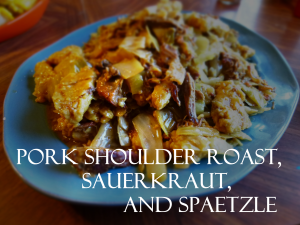Shoulder, Sauerkraut, and Spaetzle
This meal is among our favorites here at the Cadman household. Spaetzle are little flour dumplings cooked in liquid. This meal is easy and filling and simple to make extras to eat on through the week. Plus it’s one of those special dishes that are even better as leftovers!
By Jerica Cadman
Serves 6.
Ingredients:
1 pork shoulder roast, about 2.5 lb.
1 qt homemade chicken or pork broth, more as needed
1 large onion, coarsely chopped
3 cups all-purpose flour
3 eggs
1/2-1 cup buttermilk, broth, or milk (your preference)
4-6 cups homemade lactofermented sauerkraut with juice
Step 1: Cook the roast.
You have lots of options here. To oven or crock-pot your roast, follow our recipe for a basic pork shoulder roast recipe, using no seasonings (you’ll adjust the seasonings after you add the sauerkraut). Should you forget to add the onion, you can cook it with the sauerkraut, below. For this recipe, I prefer a stove-top method, as follows:
Add thawed roast, onion, and 1 qt homemade broth to a heavy-bottom pot with a lid. Bring to a boil, reduce heat and simmer for about 2-3 hours or until tender, turning the roast with a fork once or twice during cooking. If your cooking liquid evaporates too much, add a little water.
Once tender, remove meat from the bone, and set aside, keeping broth in pot for cooking the dumplings.
Step 2: Mix and cook the spaetzle.
Place flour into medium bowl and make a well in the center. Add eggs and liquid (we usually use milk) and gradually whisk together. You should have a very soft dough, but it should not be so wet that it is like a batter.
Return the broth to a boil and drop the spaetzle in using a knife or spoon, dropping about a teaspoon of dough into the boiling liquid. Repeat until all the dumplings are cooked, doing it in batches and adding more broth if necessary. Once dumplings are cooked, they will float (takes about 2 minutes). Spoon them out, leaving the broth, and set them aside with the meat.
Step 3: Cook the sauerkraut.
Normally you don’t cook lactofermented foods because the enzymes and beneficial bacteria are heat-sensitive. But I’m convinced that most of the benefits remain intact after moderate cooking, and this particular meal is more pleasant with softened sauerkraut.
With the broth still simmering strongly, add the sauerkraut and its juice. Cook about 5 minutes until tender. Add the deboned meat and cooked spaetzle and simmer for another 10 minutes. Adjust seasonings, adding salt if necessary (my sauerkraut is very salty, so I find that I don’t need to add much salt, if any).
Enjoy!



